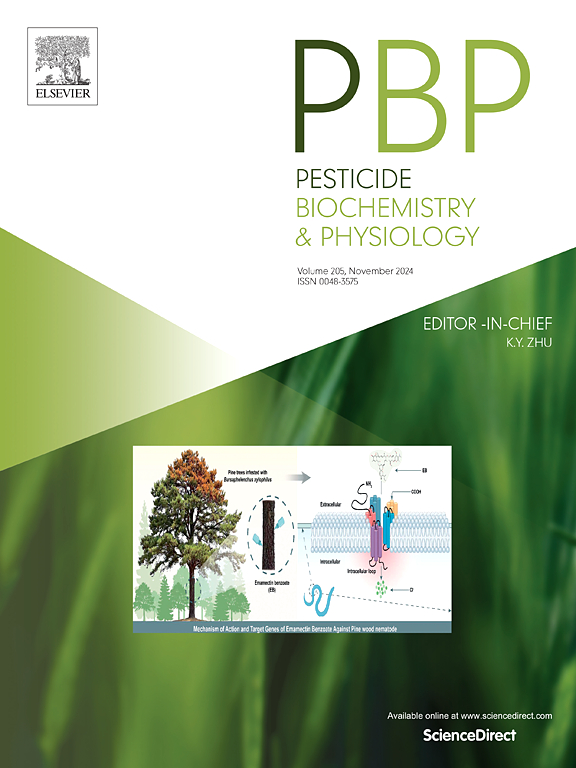Combination of L-methionine and chlorantraniliprole enhances the abundance of opportunistic pathogenic bacteria in the intestine of greater wax moth leading to increased mortality risk
IF 4.2
1区 农林科学
Q2 BIOCHEMISTRY & MOLECULAR BIOLOGY
引用次数: 0
Abstract
Honey bees play an essential role in global crop production and agro-economic development due to their pollination properties. However, empirical evidence indicates a worldwide decline in bee colonies. The greater wax moth (GWM), a lepidopteran insect and natural enemy of honey bees, significantly contributes to this decline. Chlorantraniliprole (CH) is commonly used to control GWM in apiaries due to its efficacy and low toxicity to bees. However, long-term use of CH may lead to environmental pollution and GWM resistance. To enhance beekeeping safety and mitigate the risk of GWM resistance from prolonged CH use, we investigated the toxic effects of combining methionine (MET), which has demonstrated insecticidal activity against some lepidopteran pests, with CH on GWM. We conducted both individual and mixed exposure tests of MET and CH on GWM to finally evaluate the toxic effects of the combined treatment (MIX). The results indicated that the combination of MET and CH produced a synergistic lethal effect on GWM. Subsequent microbiome and immune-related gene expression assays, along with correlation analysis, revealed that the MIX treatment significantly reducing the abundance of Enterococcus spp., the primary genus in GWM, and induced immune stress in GWM. This phenomenon led to the proliferation of opportunistic pathogens such as Pseudomonas spp., ultimately leading to synergistic lethal effects on GWM mortality. This study provides new insights and data supporting the development of MET as a potential insecticide.

l -蛋氨酸和氯虫腈联合使用可增加大蜡蛾肠道条件致病菌的丰度,导致死亡风险增加
蜜蜂的传粉特性在全球作物生产和农业经济发展中发挥着重要作用。然而,经验证据表明,全球蜂群数量正在下降。大蜡蛾(GWM),鳞翅目昆虫和蜜蜂的天敌,是造成这种下降的主要原因。氯虫腈(chlorantranilprole, CH)因其有效且对蜜蜂的毒性低而被广泛用于控制蜂房中的GWM。然而,长期使用CH可能导致环境污染和GWM抗性。为了提高养蜂安全性,降低长期使用CH对GWM产生抗性的风险,我们研究了蛋氨酸(MET)与CH对GWM的毒性作用,MET对一些鳞翅目害虫具有杀虫活性。我们对GWM进行了MET和CH的单独和混合暴露试验,以最终评估联合治疗(MIX)的毒性作用。结果表明,MET和CH联合使用对GWM具有协同致死作用。随后的微生物组和免疫相关基因表达分析以及相关分析显示,MIX处理显著降低了GWM的主要属肠球菌(Enterococcus spp.)的丰度,并诱导了GWM的免疫应激。这一现象导致机会致病菌(如假单胞菌)的增殖,最终导致对GWM死亡率的协同致死效应。该研究为MET作为潜在杀虫剂的开发提供了新的见解和数据。
本文章由计算机程序翻译,如有差异,请以英文原文为准。
求助全文
约1分钟内获得全文
求助全文
来源期刊
CiteScore
7.00
自引率
8.50%
发文量
238
审稿时长
4.2 months
期刊介绍:
Pesticide Biochemistry and Physiology publishes original scientific articles pertaining to the mode of action of plant protection agents such as insecticides, fungicides, herbicides, and similar compounds, including nonlethal pest control agents, biosynthesis of pheromones, hormones, and plant resistance agents. Manuscripts may include a biochemical, physiological, or molecular study for an understanding of comparative toxicology or selective toxicity of both target and nontarget organisms. Particular interest will be given to studies on the molecular biology of pest control, toxicology, and pesticide resistance.
Research Areas Emphasized Include the Biochemistry and Physiology of:
• Comparative toxicity
• Mode of action
• Pathophysiology
• Plant growth regulators
• Resistance
• Other effects of pesticides on both parasites and hosts.

 求助内容:
求助内容: 应助结果提醒方式:
应助结果提醒方式:


